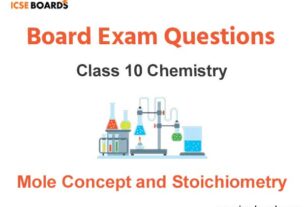Students should refer to Second Phase of The Indian National Movement Class 10 ICSE notes provided below which has been designed by ICSE Class 10 History teacher based on the latest syllabus and examination guidelines for ICSE Class 10 History. You should carefully read through and understand all topics of this chapter given below so that you can learn the concepts given in Chapter Second Phase of The Indian National Movement which will be very useful if you use them prior to your History exams.
ICSE Class 10 History Second Phase of The Indian National Movement 1905 to 1916 Summary
We have provided below a summary of Chapter Second Phase of The Indian National Movement 1905 to 1916. This is an important chapter in Standard 10th ICSE History. The summary provided below has been prepared by expert History faculty for ICSE based on the latest ICSE books. You should refer to all Chapter Summaries ICSE Class 10 History which will help you to understand all chapters and to get more marks in exams.
Second Phase of The Indian National Movement 1905 to 1916 ICSE Class 10 History
Scope of Syllabus:
• Causes of the Partition of Bengal and its perspective by the Nationalists.
• Surat Split of 1907.
• Objectives of assertive Nationalists.
• Methods of Assertive Nationalists.
• Any 2 Contributions of – Bal Gangadhar Tilak, Bipin Chandra Pal and Lala Lajpat Rai.
Introduction –
Lord Curzon was the viceroy of India from 1899-1905. His tenure of office was marked with controversies one of his administrative measures that resulted in strong resentment was the Partition of Bengal in 1905.
The Presidency of Bengal was the most thickly populated province in British India. It comprised Bengal, Bihar, Odisha, Chota Nagpur and other remote areas. On July 20, 1905 Lord Curzon announced the division of the province of Bengal into the following 2 provinces:
1) ‘Bengal’ which comprised of Western districts of Bengal Proper, Bihar and Odisha. Calcutta was made its capital. It was dominated by non-Bengali population.
2) ‘Eastern Bengal and Assam’ which comprised of the eastern districts of Bengal Proper and Assam. Dacca was its capital. It was dominated by Bengali Muslims.
The scheme of partition of Bengal was implemented on Oct. 16, 1905.
Cause of Partition of Bengal –
• According to British, the partition of Bengal was an administrative necessity because the province of Bengal was too big to be efficiently administered by a single provincial government.
• To stop the rising tide of nationalism as Bengal was the nerve centre of Indian Nationalism at that time.
• To curb the Bengali influence by dividing it into two administrations and reducing them to a minority in Bengal.
• To divide Bengal into two religious based divisions – East Bengal would be a Muslim Majority State and West Bengal, a Hindu Majority.
The Indian nationalists condemned the Partition of Bengal on the following grounds –
1) It was a deliberate attempt to divide the Bengalis on religious and territorial grounds and thus disrupt and weaken nationalism in Bengal.
2) The administrative efficiency could have been better secured by separating Hindi-speaking Bihar and the Odiya- speaking Odisha from the Bengali- speaking part of the province.
3) The announcement of Partition was made without any regard for the public opinion and it hurt the sentiments of sensitive Bengalis.
Surat Split of 1907 –
• The annual session of the Congress in 1907 was held at Surat.
• There were differences between the Early Nationalists and the Assertive Nationalists on Swadeshi and Boycott.
• The Assertive Nationalists wanted to extend the swadeshi and Boycott to rests of India and make it a political mass struggle.
• The Early Nationalists did not approve it for the whole of India and wanted it to be confined to Bengal only.
• The Early Nationalists and Assertive Nationalists sank their differences and passed a resolution of the Calcutta session in 1906 condemning the Partition of Bengal. The dispute between the two wings of the Congress was not resolved.
• There was also disagreement over the candidature of the next President.
• Dadabhai Naoroji, who was respected by both groups, became the President in 1906.
• The differences between the two sections surfaced again in the next session in 1907 at Surat.
• Assertive Nationalists proposed the name of Lala Lajpat Rai as President of the Surat Session.
• The Early Nationalists proposed the name of Rashbehari Ghosh.
• When the Surat Session began in Dec. 1907, there was utter confusion. This led to the split of the Congress and Assertive Nationalists leaders were expelled [9 years].
• The split in the congress gave on opportunity to the British to exploit the situation to their advantage.
• They adopted a policy of ‘Concession and repression’ – concession for the Early Nationalists & Muslims and repression to the Assertive Nationalists.
• Surat Split weakened the national movement.
• The Early Nationalists, were able to capture the Congress Organization and in the Allahabad Convention, held in April 1908, the split was formalized.
The Assertive Nationalists –
• In the 2nd phase of the national movement, there emerged a new and a younger group of leaders within the Congress who did not agree with the methods and ideology of the Early Nationalists leaders. They stood for complete Swaraj to be achieved by more self- reliant methods. This group of leaders came to be known as Assertive Nationalists.
• They were so called because they had a different outlook that advocated active resistance to British imperialism. They condemned the British rule in India and held it responsible for the Country’s downfall.
• Three prominent leaders of this group were Bal Gangadhar Tilak, Lala Lajpat Rai and Bipin Chandra Pal. [Lal-Bal-Pal]
Objective of Assertive Nationalists –
• The main objective of Assertive Nationalists was the immediate attainment of ‘Swaraj’.
• This means complete independence and not just self-government. as in the colonies of Australia, New Zealand etc.
Methods of Assertive Nationalists –
1) Swadeshi – It means producing necessary items in one’s own country and using them for one’s use without being dependent on imported goods. The swadeshi idea was popularized by occasional bonfires of foreign cloth, salt and sugar.
2) Boycott – Economic boycott of British goods and use of Swadesh was designed to encourage Indian industries and provide the people with more opportunities for employment. It proved as a most effective weapon for harming British interests in India.
3) National Education- A National scheme of education was planned which was a to replace that of Government controlled universities and colleges. The Assertive Nationalists tried to enlist the students in their service. When the British Government threatened to take disciplinary action against the students, the national leaders advocated national universities that were free from Government control. Many national schools were established in East Bengal. In Punjab, the D.A.V. movement made considerable effort in spreading education through various schools and colleges. Education was also given in vernacular languages.
4) Passive Resistance – Assertive leaders believed in adopting the policy of non-violent resistance and vigorous political action to achieve their aims. They asked the people to refuse to co-operate with the government and to boycott government service, courts, schools and colleges. They advocated courage, self-confidence and a spirit of sacrifice to achieve their goal of swaraj.
5) Mass involvement – They had an abiding faith in the strength of the masses and proposed to win freedom through mass action. They aroused the masses by influencing them with their sacrifices and suffering.
LEADERS OF ASSERTIVE NATIONALISM
Bal Gangadhar Tilak [1856-1920]
- He was known as the ‘Father of the Assertive Nationalism’.
- Tilak was the first to openly declare the demand for swaraj. “Swaraj is my birth right and I shall have it.”
- He set up a Home Rule League at Pune to attain self-government within the British Empire.
- He used traditional religious Ganapati Festival to propagate nationalism through songs and speeches. He started Shivaji Festival to encourage young Maharashtrians.
- He started two newspapers- Maratha [English] and Kesari [Marathi]. Through these newspapers he preached nationalism and taught the people to be courageous and self-reliant.
- He wrote two well-known books- the Gita Rahasya and The Arctic Home of the Vedas.
- He founded the Deccan Education Society under Justice Ranade’s guidance. The society set up many educational institutions. 8. Forerunner of Gandhiji –
(i) Tilak was the forerunner of Gandhi in many ways.
(ii) Tilak’s ideas of swaraj were akin to Mahatma Gandhi’s idea of complete independence.
(iii) Tilak sought close contact with the masses as Gandhi did.
(iv) Tilak preached the idea of Swadeshi, Boycott and Prohibition. These ideas were preached and followed by Gandhi later on.
Bipin Chandra Pal [1858-1932]
- Known as ‘Father of the Revolutionary Thought in India.’He worked for ‘Bengal Public Opinion’. The Tribune and ‘New India’ to propagate nationalism.
- He wanted to remove social and economic evils from the society for which he made the following efforts:
- (i) He opposed the caste system and other rigid rules concerning inter-dining and inter-mixing
(ii) Advocated widow remarriage.
(iii) He believed that, educating women was the most effective way of elevating their position.
(iv) He preached the use of Swadesh and the Boycott of foreign goods to eradicate poverty and unemployment.
(v) He demanded 48 hours of work in a week and increase in the wages.
(vi) To establish equality in society, he wanted to tax the rich more heavily than the poor.
Lal Lajpat Rai [1865-1928]
- Known as ‘Punjab Kesari’ or ‘Sher-e-Punjab’
- He started a monthly magazine ‘Young India’ to spread the message of the ‘Right of India to attain Swaraj’.
- His other publications included ‘The call to Young India’, ‘England’s Debt to India’ and ‘The Political Future of India’.
- He founded ‘Punjabi’, ‘Vande Mataram’ and ‘People’ [English weekly].
- He wrote a book on ‘National Education’ that called for reform of the prevalent educational system.
- He set up ‘Servants of the People Society’ for the welfare of the downtrodden and out casts.
- In 1920 he was elected president of the Indian National Congress.
DIFFERENCE BETWEEN EARLY & ASSERTIVE NATIONALISTS

IMPORTANT EVENTS, YEARS & DATES



